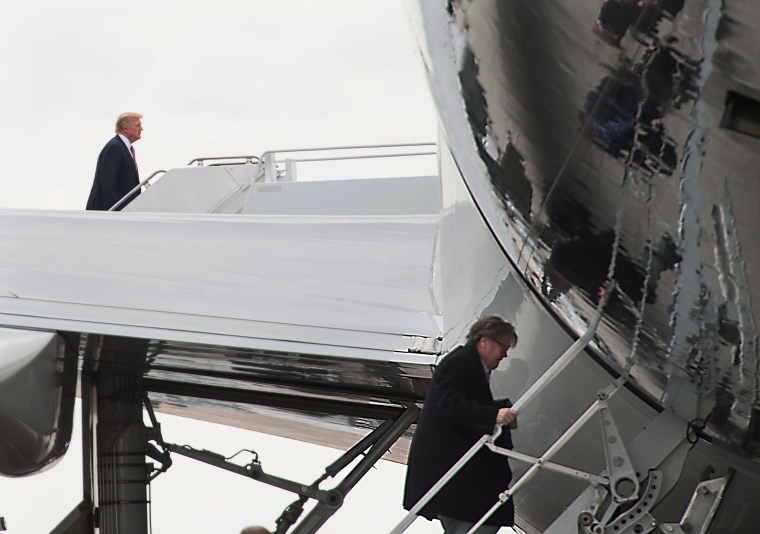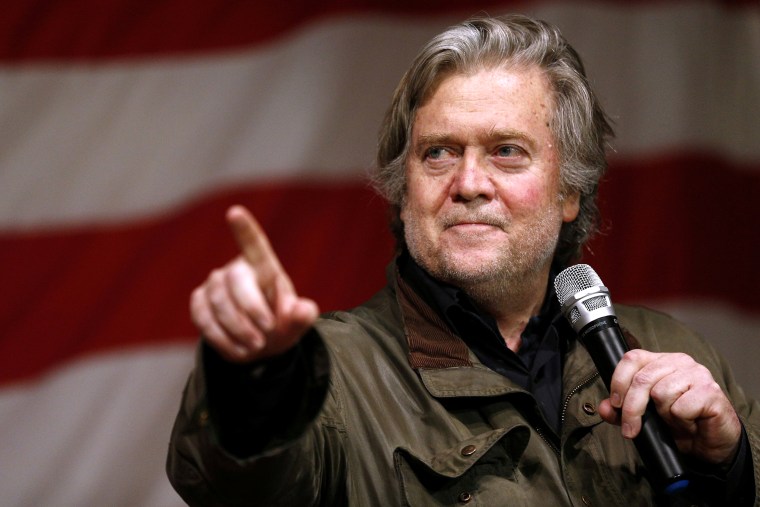On Tuesday, Steve Bannon announced that he was resigning from Breitbart News in light of a public spat between him and Donald Trump following the publication of Michael Wolff’s salacious “Fire and Fury.” Wolff’s tell-all portrayed Bannon as a short-tempered advisor futilely trying to guide a clueless president. Shortly after, SiriusXM announced that Bannon’s radio show would be canceled, while multiple outlets reported that right-wing mega-donor Rebekah Mercer had withdrawn her financial support. Finally, Bannon himself stepped down from his influential post as Executive Chairman at Breitbart.
Bannon’s rise and subsequent downfall — from campaign manager to White House chief strategist to rebound media mogul to unemployed enabler of white supremacy — was celebrated by those who, quite reasonably, never thought the Darth Vader-praising blowhard with a long record of publishing bigoted conspiracy theories should have had influence over U.S. policy in the first place. Bannon had sought to “deconstruct the administrative state”; In the end, it looked like the administrative state deconstructed Bannon.
But don’t get too excited. The Trump administration has birthed a cottage industry of flamboyant flame-outs in its first year. On several occasions, former staffers whose deservedly dead careers have been quickly revived by the media, who treat the exiled Trumpers as a sideshow to the main circus. They may no longer dictate policy directly, but they contribute to a collective normalization of extremist movements and an administration that shatters democratic norms and possibly laws.
The Trump administration has birthed a cottage industry of flamboyant flame-outs in its first year.
Fired campaign advisors Roger Stone and Michael Caputo, despite being questioned as part of the Russia interference probe, are routinely solicited for media commentary, as is former advisor Seb Gorka (accused of Islamaphobia and Nazi sympathizing, among other things) and former Communications Director Anthony Scaramucci (best known for his ten-day tenure and for speculating that Bannon performs auto-fellatio.) No idiocy from these stalwarts of white male mediocrity is too great to go unrewarded: Sean “Holocaust Centers” Spicer became a fellow at Harvard.
Importantly, despite being booted, the ex-Trump staffers usually use their public platforms to continue to praise Trump and defend the administration. This synergy is reminiscent of “Celebrity Apprentice” — even “fired” D-listers remain loyal to the boss who made them, because notoriety, in the amoral vacuum of a reality-TV world, is the ultimate currency.
Though second chances for Trump lackeys abound — strangely, no one is telling these men to stay home and knit — Bannon’s case is unique and potentially dangerous. Bannon’s political rise was part of a broader mainstreaming of the most extreme elements of the conservative and alt-right movements — something exemplified by Bannon-helmed Breitbart, but streamlined even in liberal outlets like the New York Times, which ran a series of puff pieces on neo-Nazis. Purposeful or not, such pieces made these figures more palatable to the public. As hate crimes rise to record highs, so, perversely, does media tolerance of white supremacists. This is not to say that all or even most media outlets are complicit, but it does seem that bigoted groups and individuals once consigned to the fringes now have new paths to publicity.

Like Trump, Bannon has repeatedly deemed the media his enemy while knowing full well that it is his friend. Bannon’s neo-Nazi ties, support for alleged pedophiles like Roy Moore, and apparent desire to destroy the U.S. are irrelevant to some media elites who consider his fame more important than his actions.
In some ways, this rehabilitation is already happening. A late December Vanity Fair profile speculating on Bannon as a future presidential candidate presents him at times as a jovial debate partner: “Bannon shook my hand graciously,” writes Gabriel Sherman. “He told me he enjoyed my book on Ailes. What about all the hit pieces he published? ‘Ha! Those were love taps, dude. Just business.’ We proceeded to have a highly entertaining lunch swapping media and political gossip. As much as I wanted to loathe Bannon — the Breitbart attacks were genuinely terrifying — I found myself liking him.”
It is very easy, in this media environment, to imagine Bannon rebranding himself and continuing his quest for power — turning his Breitbart-honed bullhorn back into a dog whistle while appealing to alienated Trump supporters and other disillusioned Americans willing to tolerate bigotry. The former Goldman Sachs banker may position himself as an economic populist — a persona he has often embraced to temper or justify his more bigoted beliefs — in order to win adherents from across the political spectrum.
One hopes few will fall for it. After all, Bannon was the chief advisor of an administration whose policies support only the rich. But don’t hold your breath: Trump successfully ran as a populist while living in a golden tower as a self-professed billionaire.
Bannon has the additional advantage of being seen as in opposition to the widely detested Trump, whether he truly is or not. Thanks to Trump's Twitter meltdowns, his promotion of a tax bill that rigs the economy for the rich for decades, and his incessant war-mongering, Trump’s approval numbers have sunk to a record low.
Bannon has the additional advantage of being seen as in opposition to the widely detested Trump, whether he truly is or not.
In “Fire and Fury,” Bannon frequently comes off as enraged, but for good reason: He is being forced to manage an imbecile president. In Wolff’s portrayal, the racist rhetoric is simply something Bannon uses to rile up liberals, prompting them to do things like protest the Muslim ban at the airport — deep down his commitment to populist ideology is sincere. Much as “Fire and Fury” may help Trump by bolstering the GOP’s “He’s too inexperienced to have committed a crime” excuse, the controversial account also makes Bannon seem competent by default.
Throughout his year and a half in the spotlight, Bannon attached himself to the most reprehensible of causes while cavalierly attacking basic constitutional principles such as freedom of religion and a free press. He did this openly, and venomously, yet ended the year with speculation of a 2020 presidential run and a best seller which presents him as the lesser of two evils.
The problem, it is clear, goes beyond Bannon, whose influence will likely outlive his current position. The problem is the mainstreaming of extremists by the media and the downplaying of the real-world consequences of white supremacy for non-whites and immigrants who suffer under Trump administration policies.
Bannon, like Trump, is a master of spin, and being removed from the White House and Breitbart doesn’t necessarily mean his power will wane, despite the many thinkpieces already proclaiming his political humiliation complete. Furthermore, Bannon is part of a broader cultural movement that will likely spur slicker successors — a movement that has already shown formidable mastery of media and political positioning. The greatest danger is that the hate rhetoric peddled by Bannon will yet be repackaged in an even more palatable form — and that many in the public will buy in.
Sarah Kendzior is a journalist who lives in St. Louis, Missouri and covers politics, the economy and media.

